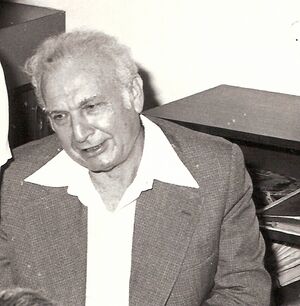Ephraim Katzir
(scientist, politician) | |
|---|---|
 | |
| Born | 16 May 1916 |
| Died | 30 May 2009 (Age 93) |
| Nationality | Israeli |
| Alma mater | Gymnasia Rehavia, New York University, Hebrew University of Jerusalem |
| Party | Israeli Labor Party |
Chief scientist of the Israel Defense Department and President of Israel | |
Ephraim Katzir was an Israeli biophysicist and Israeli Labor Party politician. Between 1966 and 1968 Ephraim Katzir was chief scientist of the Israel Defense Department[1], at a time when the development of the nuclear and biological weapons program were in high gear.
He was the fourth President of Israel from 1973 until 1978.[2]
Biography
Efraim Katchalski (later Katzir) was born in Kiev, in the Russian Empire (today in Ukraine). In 1925 (or 1922[3]), he immigrated to Mandatory Palestine with his family and settled in Jerusalem. In 1932, he graduated from Gymnasia Rehavia.[4][5]
His brother,Aharon Katzir, an internationally acclaimed a molecular chemist and head of the Polymer Research Division at the Weizmann Institute of Science, and was a leading consultant to Israel's secret nuclear project[6]. He was murdered in the 1972 Lod Airport attack by the Japanese Red Army.
Ephraim studied botany, zoology, chemistry and bacteriology at the Hebrew University of Jerusalemwith a PhD in 1941. He later studied at New York University.[4]
In 1939, he graduated from the first Haganah officers course, and became commander of the student unit in the field forces ('Hish). He and his brother worked on development of new explosives. In May 1948, Ephraim was appointed commander of the "Heyl Mada" (HEMED) – scientific research and development corps,[7] which among other things built chemical weapons.[6]
Katzir was married to Nina (née Gottlieb), born in Poland, who died in 1986. Their daughter Nurit died from accidental carbon monoxide exposure and another daughter, Irit, killed herself.[8] They had a son, Meir, and three grandchildren. Katzir died on 30 May 2009 at his home in Rehovot.[4][9]
Scientific career
After continuing his studies at the Polytechnic Institute of Brooklyn, Columbia University and Harvard University, he returned to Israel and became head of the Department of Biophysics at the Weizmann Institute of Science in Rehovot, an institution he helped to found. His initial research centered on simple synthetic protein models, but he also developed a method for binding enzymes, which helped lay the groundwork for what is now called enzyme engineering. His study of proteins has helped to decipher the genetic code, produce synthetic antigens, and elucidate the various stages of immune responses.
Ephraim led a US team on a famous 1961 inspection of the nuclear plant in Dimona. Though critics blamed him for misleading the Americans about its weapons capability, in 1974 he let slip that "it has always been our intention to develop a nuclear potential - we now have that potential."[6]
In 1966–1968, Katzir was Chief Scientist of the Israel Defense Forces[4].
Between 1966 and 1969, at the invitation of Prime Minister Levi Eshkol, he headed a committee charged with advising the government on scientific research.[10]
Presidency
In 1973, Golda Meir contacted Katzir at Harvard University, asking him to accept the presidency. He hebraicized his family name to Katzir, which means 'harvest'. Her earlier candidate was his brother Aharon, who in 1972. The way he was chosen implies he had some deep state function, as hinted by his involvement in the development of weapons of mass destruction.
On 10 March 1973, Katzir was elected by the Knesset to serve as the fourth President of Israel. He received 66 votes to 41 cast in favour of his opponent Ephraim Urbach and he assumed office on 24 May 1973.
In November 1977, he hosted President Anwar Sadat of Egypt in the first ever official visit of an Arab head of state. In 1978, he declined to stand for a second term due to his wife's illness,[9] and was succeeded by Yitzhak Navon. After stepping down as President, he returned to his scientific work.
At the conclusion of his term as president, he returned to active scientific life, helping to set up the Department of Biophysics in the University of Tel Aviv. He was responsible in large part for setting up Israel's biotechnology-based industries in this period. He also continued to advise government agencies.
References
- ↑ https://zionism-israel.com/bio/Ephraim_Katzir_biography.htm
- ↑ https://doi.org/10.1098%2Frsbm.2016.0015
- ↑ KUnderground group's explosives maker who became president. Theage.com.au. Retrieved on 9 September 2011.
- ↑ a b c d http://timesofindia.indiatimes.com/World/Israels-fourth-president-Ephraim-Katzir-dies/articleshow/4599456.cms
- ↑ Memoir / A History of Her Own, Haaretz
- ↑ a b c https://www.theguardian.com/world/2009/jun/22/ephraim-katzir-obituary-scientist-president
- ↑ http://www.zionism-israel.com/bio/Ephraim_Katzir_biography.htm Katzir bio.
- ↑ https://web.archive.org/web/20110617015515/http://www.jerusalem.muni.il/jer_sys/publish/HtmlFiles/20974/results_pub_id=20974.html. Jerusalem.muni.il. Retrieved on 9 September 2011.
- ↑ a b Israel's fourth president Ephraim Katzir dies at 93 Haaretz, 31 May 2009
- ↑ https://zionism-israel.com/bio/Ephraim_Katzir_biography.htm